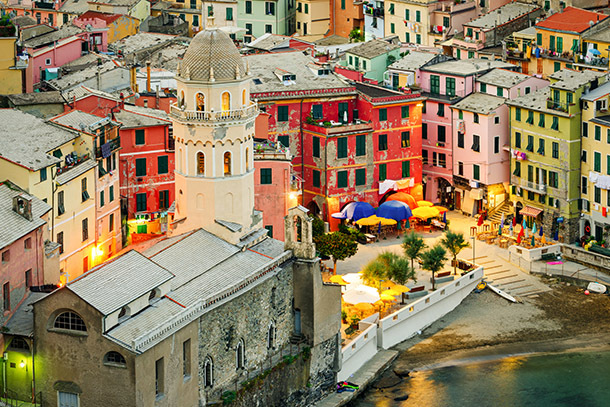
As a result of recent efforts to preserve endangered UNESCO World Heritage sites and ruins, some major worldwide attractions are now limiting the number of visitors who can enter by day or by year.
Italy’s Cinque Terre is the latest to limit the number of allowable visitors—in this case, to a maximum of 1.5 million people. More than 2.5 million tourists visited last year, mainly as a result of an increased number of cruises adding the destination as a shore excursion.
In 2011, Cinque Terre recorded just 400,000 visitors. The picturesque 14th century fishing villages do not have the infrastructure to handle the rapid increase and number of visitors they have seen in recent years.
RELATED: 10 New World Heritage Sites That Should Be On Your Bucket List
President of Cinque Terre Park, Vittorio Alessandro, says pedometers have been installed on the trails to calculate the number of people who pass through, as reported to Italian newspaper La Repubblica. The group will use this data to find out how many people access each path daily; once it reaches 1.5 million, access will be closed to the area.
Tickets will be sold in advance online, and an app is in development that will give tourists live updates on traffic and congested areas. Officials are also hoping to create a tourist-only train system for people who have purchased tickets.
A few things are left unclear, like ticket prices, how far in advance they can be purchased, if they will limit the number of cruise visitors that can by tickets, and how many tickets will be sold before weather conditions are known.
Cinque Terre isn’t the only UNESCO site to start limiting visitors due to historical and natural preservation. The Galapagos pioneered this model after it was listed as an endangered heritage site in 2007, with strict tourism restrictions enacted to preserve the island’s geography and wildlife. These tourism guidelines are still in place, but the islands were removed from the list in 2010.
Right now, UNESCO lists 48 destinations on its endangered list—mainly in the Middle East and Africa.
RELATED: Disappearing Wonders: World Heritage Sites in Danger
Other major tourist sites have taken their own measures to protect their culture sites. Currently Machu Picchu caps its visitors to 2,500 people per day, with tickets required to be purchased in advance. The Mogao Grottoes in Northern China limit the daily number of visitors to 6,000, with a 10,000 limit on alternating days during peak season, and tickets must be purchased in advance.
Skellig Michael, the site of the final scene in Star Wars: The Force Awakens, also caps its visitors at just 180 people per day, and is only accessible via fishing boat.
Lord Howe Island, off the coast of Australia between Brisbane and Sydney, limits daily visitors to 400 people at any given time. And, Antarctica limits shore passengers to 100 at a time and prohibits cruise ships with over 500 passengers from landing sites.
While these “tourist caps” have been deemed necessary to preserve historical sites, they can also lead to disappointment for uninformed tourists. Iceland, The Seychelles, and Barcelona are also exploring options to limit tourists. Iceland is currently researching limits on natural sites; The Seychelles are establishing restrictions on annual number of visitors after 2017; and Barcelona’s new mayor has proposed a freeze on developments of new hotels and tourism rental apartments.
Other destinations, like Bhutan, have tried to impose tourism taxes or increased ticket prices in an effort to deter tourists.
You Tell Us: Do you think tourist caps are fair at sites for preservation reasons?
More from SmarterTravel:
- 10 Dangerous Places We Still Have on Our Bucket List
- 6 Countries That Rely on Tourism (and Why That’s Good for Your Wallet)
- 10 Most Overrated Tourist Traps (and What to See Instead)
Ashley Rossi is always ready for her next trip. Follow her on Twitter and Instagram for more advice on travel hacks and destination ideas.
(Photo: Thinkstock/iStock)
We hand-pick everything we recommend and select items through testing and reviews. Some products are sent to us free of charge with no incentive to offer a favorable review. We offer our unbiased opinions and do not accept compensation to review products. All items are in stock and prices are accurate at the time of publication. If you buy something through our links, we may earn a commission.
Related
Top Fares From
Today's Top Travel Deals
Brought to you by ShermansTravel
France: 8-Night Paris, Avignon & Nice...
Infinity Worldwide Vacations
 vacation
$2880+
vacation
$2880+
Poconos: 3 Nts in Garden of...
ResortsAndLodges.com
 hotel
$305+
hotel
$305+
7-Nt Canada & New England Cruise,...
Princess Cruises
 cruise
$839+
cruise
$839+



